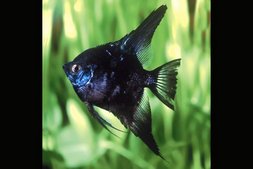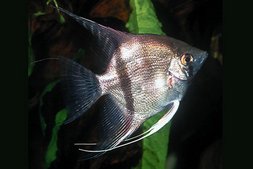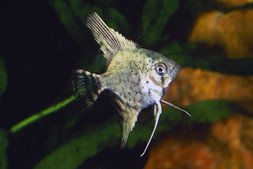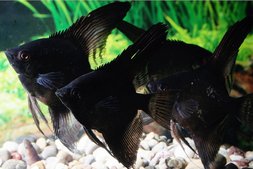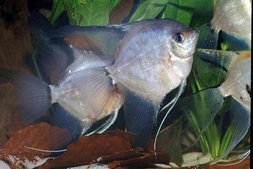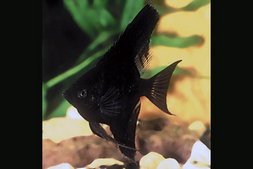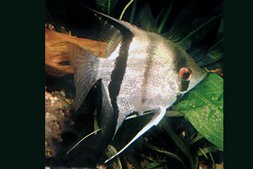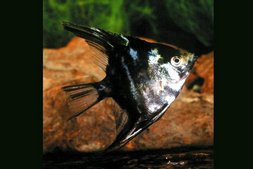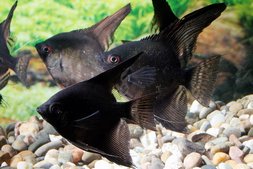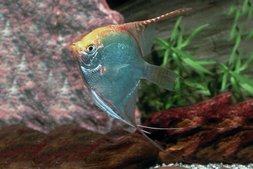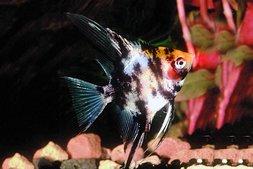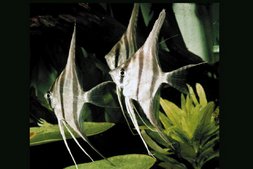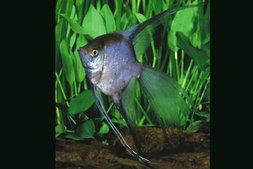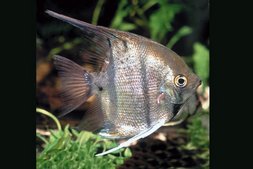Freshwater Angelfishes
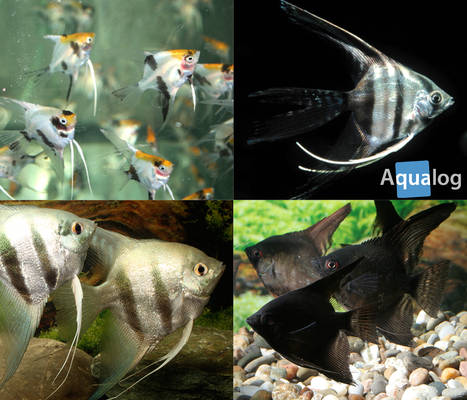
Freshwater angelfishes, usually known as angels, are a genus in the cichlid family (Cichlidae). There are officially only three species recognised, the Common Angel(fish) (Pterophyllum scalare), the Altum Angel(fish) (Pterophyllum altum), and Dumeril’s Angel(fish) (Pterophyllum leopoldi). The name Pterophyllum means “fin-leaf” and refers to the finnage; scalare means “ladder-like” and refers to the pattern of vertical dark stripes seen in the wild forms; altum means “deep” and refers to the top-to-bottom size of the fish; and leopoldi means “of Leopold”, to honour the King of Belgium. The Common Angel, is very widespread throughout the entire Amazon region and Guyana, and within this range there are numerous local variants (which may in fact be separate species). Over the course of the last 100 years crossing these local variants has resulted in numerous cultivated forms such as Black Angels, Gold Angels, Zebra Angels, Smoke Angels, Half-Black Angels, Marbled Angels, Veil-Fin Angels, Gold-Head Angels, Koi Angels, etc. In addition to these cultivated forms there are also various pure-blooded wild forms, e.g. Manacapuru Angels, sold as both wild-caught and captive-bred specimens.
Altum Angels, often termed just Altums, are mainly wild-caught, though recently they have been bred increasingly in the trade. The Dumeril’s Angels in the trade are almost exclusively wild-caught.
Important requirements
Above all Angels require a deep aquarium, as they become nervous in shallow tanks, and this causes negative stress, which makes the fishes susceptible to disease. Common Angels, their cultivated forms, and Dumeril’s Angel require aquaria at least 40 cm deep, with 50 or 60 cm being better and the minimum for adult Altums. The aquarium length is of secondary importance, and any aquarium of adequate depth with a length of 80 cm upwards and a width of 40-50 cm wide will be suitable. All wild-caught specimens, but in particular the Altum Angel, are extremely sensitive to a high bacterial count in the water. This can be countered via partial water changes and an acid pH, and perhaps the use of a UV sterilizer. Tank-breds are less demanding in this respect, but even so excellent water hygiene is critical for optimal development into splendid specimens.
Appropriate feeding
Angels are primarily carnivorous by nature. They can be easily and adequately fed with all the normal types of aquarium fish food (dry, frozen, and live). In the case of dry food it must be borne in mind that the quality of the raw ingredients determines the quality of the food. Cheap dry foods usually contain cheap ingredients that are poorly metabolised by the fishes. The result is inadequate nutrition and totally unnecessary pollution of the water, as low quality proteins and fats remain undigested and are excreted, considerably increasing bacterial proliferation in the water. For this reason – and this applies to all ornamental fishes – use the best quality food available, as cheap food is a false economy! This is particularly necessary in the case of angels because of their high sensitivity towards bacterial pollution of the water.
Correct maintenance
Regular large partial water changes are the most important element of maintenance. These changes should be made using conditioned, fresh water and the difference in temperature between the new water and the aquarium water should not exceed 2-4 °C. The new water may be cooler, never warmer, than the aquarium water.
Soft acid water limits the development of potentially harmful bacteria; anyone who decides to use such water for angels must make sure that a supply of such water is always available for the necessary water changes. To strengthen the immune response of the fishes there should always be secondary plant material (primarily humic acids)
in the aquarium; peat filtration, alder cones, or dead beech leaves can be used, or special liquid preparations added at every water change.
As a rough rule of thumb 20-25% of the tank volume can be changed weekly. Obviously the interval between water changes will depend on the aquarium size and the fish population density; in the case of large, sparsely populated aquaria it can be stretched out to every 2-3 weeks, but should be every 2-4 days in heavily populated tanks.
Aquarium and tankmates
Angels are peaceful fishes, but, like all cichlids, they are territorial. Outside the breeding season they live in loose groups, so-called shoals. At breeding time pairs form from these shoals and spawn then protect the eggs and young together.
To produce this typical behaviour the angel aquarium should contain a well-designed decor of bogwood, rocks, and aquatic plants. The substrate should consist of sand or fine gravel. Good filtration and some water movement will be appreciated by these fishes, which are elegant swimmers regardless of their low-profile body shape.
Life expectancy
Angels can live for 8-10 years.
Size
Angels grow rapidly initially and are sexually mature at the age of six (scalare) or 9-12 (altum) months. At this point they are half to two thirds of their eventual size. An angel should be full-grown at 2-2.5 years old.
Special details
One special point to remember about angels is that their long fins induce some fishes to keep nipping at them. This can ultimately lead to negative stress and increased susceptibility to disease in the angels. Hence they should not be kept together with such fishes. Particularly notorious fin-nippers include the Tiger or Sumatra Barb (formerly Barbus or Puntius tetrazona, now assigned to the genus Puntigrus; the correct name is Puntigrus anchisporus, but it will undoubtedly be decades before the correct name becomes established in the trade), the Flame Tetra (Hyphessobrycon flammeus), and the Serpae Tetra group (Hyphessobrycon eques, H. “minor”, H. callistus).





